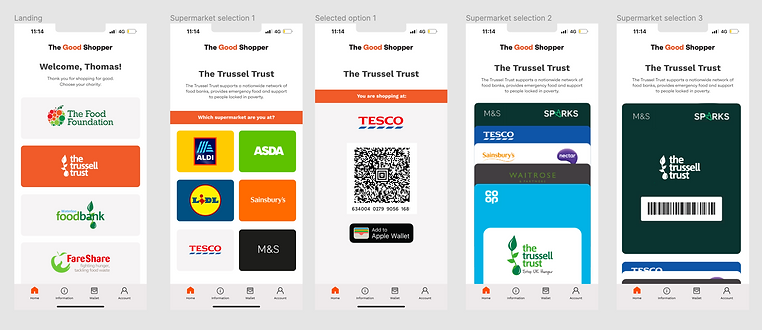
The Good Shopper
CLIENT
IBM
LOCATION
London
TIMELINE
6 weeks
YEAR
2022
WORKED WITH

Desire Obah
Designer

Sofia Alexiou
Designer

Dora Alvarez
Designer

Mu Lin
Videographer
Summary
In collaboration with IBM, we designed a system that attempts to equalise the extractive transaction of data from shoppers by supermarkets, through depersonalisation.
My role
-
Led and developed a plan of action for the User Experience across all features of the solution.
-
Led discovery and testing, conducting desktop research and interviewing over 20 prospective users.
-
Developed core features and the overall visual identity.
-
Created wireframes and the deliverables: mobile application, cards, and flyers.
💡 Design a way to take advantage of other people's digital transactions without them knowing.
Ideation
When we first got the brief, the group was rather perplexed, questioning the ethicality of the brief.
The brief essentially had three parts: 1) take advantage (indicating a goal) 2) digital transactions, and 3) without them knowing. I therefore proposed that we methodically list digital transactions and potential benefits (goals). Narrowing down digital transactions that were more interesting, we then ‘mixed and matched’ between them.


Further narrowing down into four initial ideas, I arranged them in a prioritisation matrix.

Idea 1 was quickly scrapped upon quick testing with coursemates, who felt that they would feel like their privacy is invaded if they felt an application tracking their listening history. Deciding between the remaining three ideas, idea 3 had the highest value and required the lowest effort, and so we made some quick screens for feedback.

Understanding that groceries bought are only a small part of the transactions that supermarkets tracked, we were encouraged to look deeper into loyalty schemes and their exploitative nature.
This was exciting as we’d kept getting stuck with the ethicality of us taking advantage of people without them knowing. The idea that we could flip that, by designing against something that already takes advantage of people not knowing, was a breakthrough in the ideation process.
Context
Supermarkets are locations in which many digital transactions occur. On closer inspection, they are highly extractive of shoppers, building up demographic profiles from shopping patterns (even down to payday). These are then sold for large profits, whilst shoppers get extremely small rewards that go largely unused.


1. EXTRACTION AND PROFIT
Supermarkets collect huge amounts of data from the digital transactions shoppers make on their loyalty cards.
Detailed consumer profiles are then sold to competitor brands.
Tesco sold 53 million pounds of data in 2011¹. Recent figures not available online.
2. AN UNEQUAL EXCHANGE
In comparison to the profit made, shoppers get extremely small rewards.
£1.50 voucher for every £150 spent²

£2.50 voucher for every £500 spent³
Fast track access to the latest products for every £300 spent⁴
Vouchers and rewards instead of points⁵
Vouchers (Lidl treats)⁶
Vouchers⁷
3. WASTE
Even the rewards people do get, go largely unused.
Brits build up an estimated £6 billion worth of yearly uncollected shopping rewards and vouchers on schemes e.g. Nectar, Boots, Tesco etc.⁸

How can we make this exchange more equal?
Could we extract back to our benefit?
Idea development
We took the route of depersonalising the data gathered by supermarkets. Investigating where we could intervene, we first proposed an app where people could swap their Tesco Clubcard QR codes. Shoppers would still be able to take advantage of Clubcard prices, but Tesco would not be able to build accurate shopper profiles.


Rough wireframes used for testing
We ran this idea by shoppers in informal interviews, from which we noted that people might need a stronger incentive to buy into our initiative, especially as they liked personalisation to their ads. We realised that limiting our user base to people who just wanted to disrupt the system would not be the most strategic.
💡 We therefore added the element of shopping for charities, aiming to include a wider base of shoppers by introducing an altruistic benefit.
Concept
Without registering for a subscription, people use supermarket club cards linked to food-based charities, so that the charities can use the rewards and vouchers generated by people’s purchases.
The more we buy, the less they know
The more we donate, the less they can shut it down
How it works

Interviews
I led interviews with shoppers at three Tesco stores and two Marks and Spencers stores in Central London. A majority of shoppers were open to our idea, and a majority also preferred physical cards to a mobile application. Below is a short compilation of shoppers who agreed to be recorded.
Outcomes
Mobile Application
From testing with shoppers from M&S, we found that most preferred a mobile application as opposed to physical loyalty cards.
Therefore, I created some screens to show how shoppers could choose a charity to shop for.

Quick wireframes for screens

Screens (Figma)
Flyers
and cards

Selection: Option 1

Selection: Option 2
I also designed flyers and cards that could be distributed at the charities themselves.



Accolades
"We get a lot of projects based on data and privacy on this course. This is the best one we've seen so far."
– Dr. Alaistair Steele, Course Leader on the MA User Experience Course, UAL
"It's really smart. I'd want to take part, to be honest."
– Michael Pecirno, Designer at Takram, London
Reflection
We spent a lot of time on concept development in this project. Whilst it was initially rather frustrating to not be able to get to a satisfactory idea, once we did, it was extremely fulfilling to develop it further. If given the opportunity, I hope to take this further.